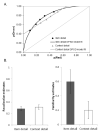Associative memory in aging: the effect of unitization on source memory
- PMID: 23527745
- PMCID: PMC3760335
- DOI: 10.1037/a0031566
Associative memory in aging: the effect of unitization on source memory
Abstract
In normal aging, memory for associations declines more than memory for individual items. Unitization is an encoding process defined by creation of a new single entity to represent a new arbitrary association. The current study tested the hypothesis that age-related differences in associative memory can be reduced by encoding instructions that promote unitization. In two experiments, groups of 20 young and 20 older participants learned new associations between a word and a background color under two conditions. In the item detail condition, they had to imagine that the item is the same color as the background-an instruction promoting unitization of the associations. In the context detail condition, which did not promote unitization, they had to imagine that the item interacted with another colored object. At test, they had to retrieve the color that was associated with each word (source memory). In both experiments, the results showed an age-related decrement in source memory performance in the context detail but not in the item detail condition. Moreover, Experiment 2 examined receiver operating characteristics in older participants and indicated that familiarity contributed more to source memory performance in the item detail than in the context detail condition. These findings suggest that unitization of new associations can overcome the associative memory deficit observed in aging, at least for item-color associations.
Figures



References
-
- Bader R, Mecklinger A, Hoppstädter M, Meyer P. Recognition memory for one-trial-unitized word pairs: Evidence from event-related potentials. NeuroImage. 2010;50:772–781. - PubMed
-
- Badham SP, Estes Z, Maylor EA. Integrative and semantic relations equally alleviate age-related associative memory deficits. Psychology & Aging. 2012;27(1):141–152. - PubMed
-
- Bartlett JC, Shastri KK, Abdi H, Neville-Smith M. Component structure of individual differences in true and false recognition of faces. Journal of Experimental Psychology : Learning, Memory and Cognition. 2009;35:1207–1230. - PubMed
-
- Chalfonte BL, Johnson MK. Feature memory and binding in young and older adults. Memory and Cognition. 1996;24(4):403–416. - PubMed
-
- Cohn M, Emrich SM, Moscovitch M. Age-related deficits in associative memory: The influence of impaired strategic retrieval. Psychology and Aging. 2008;23(1):93–103. - PubMed
Publication types
MeSH terms
Grants and funding
LinkOut - more resources
Full Text Sources
Other Literature Sources
Medical

